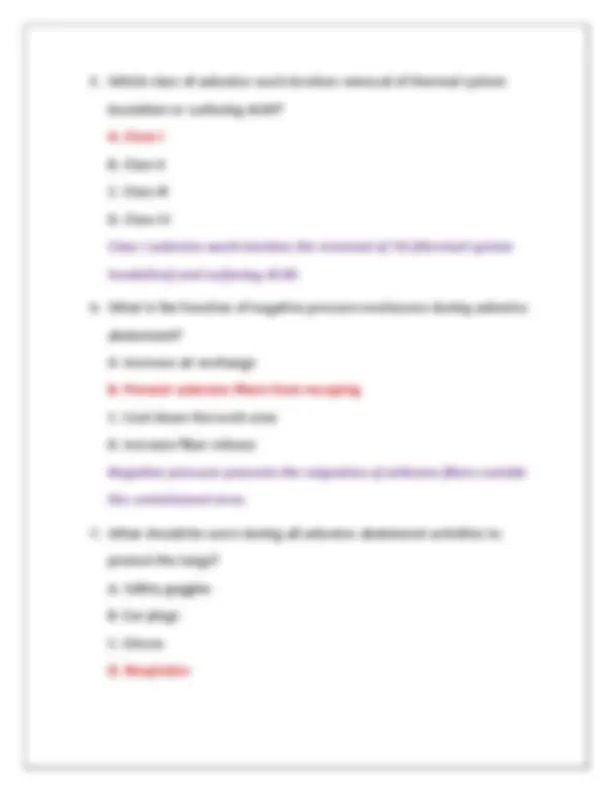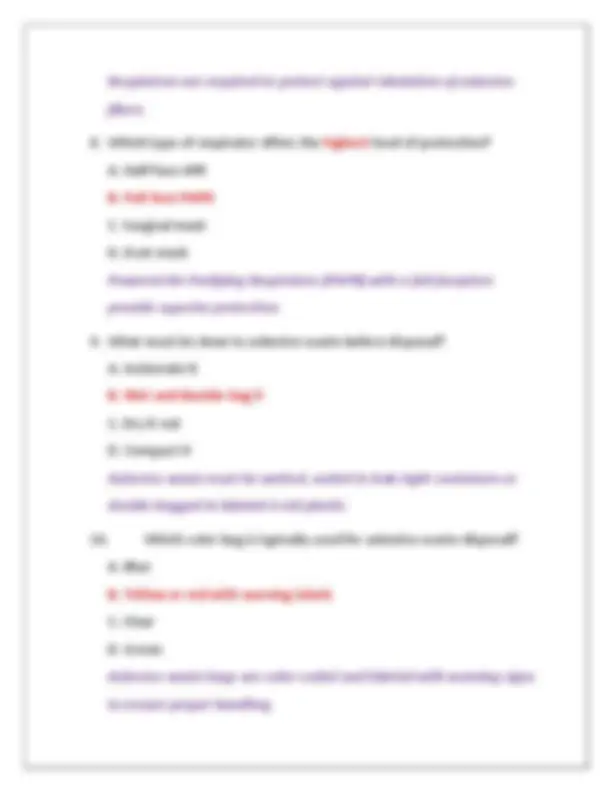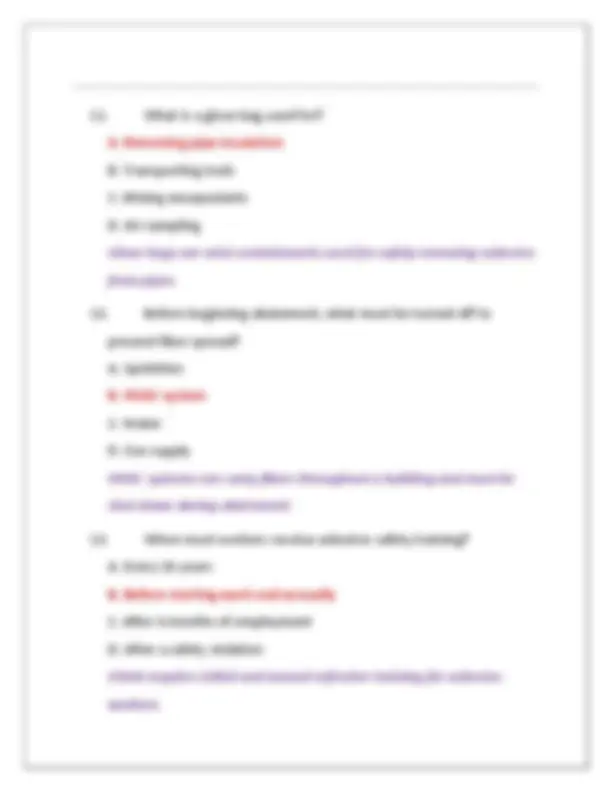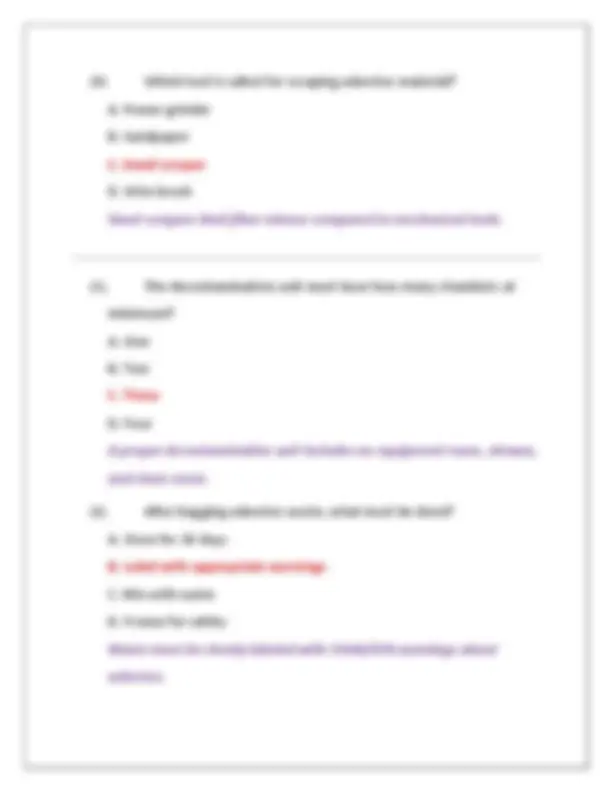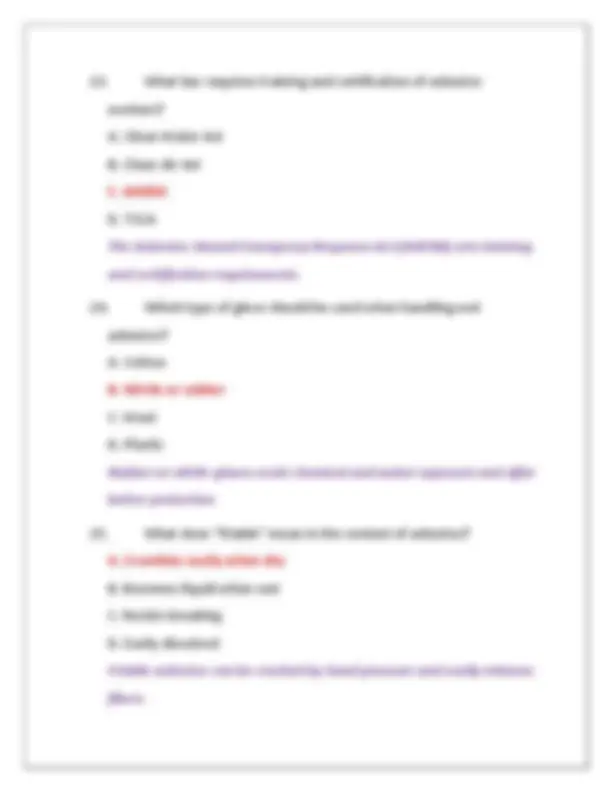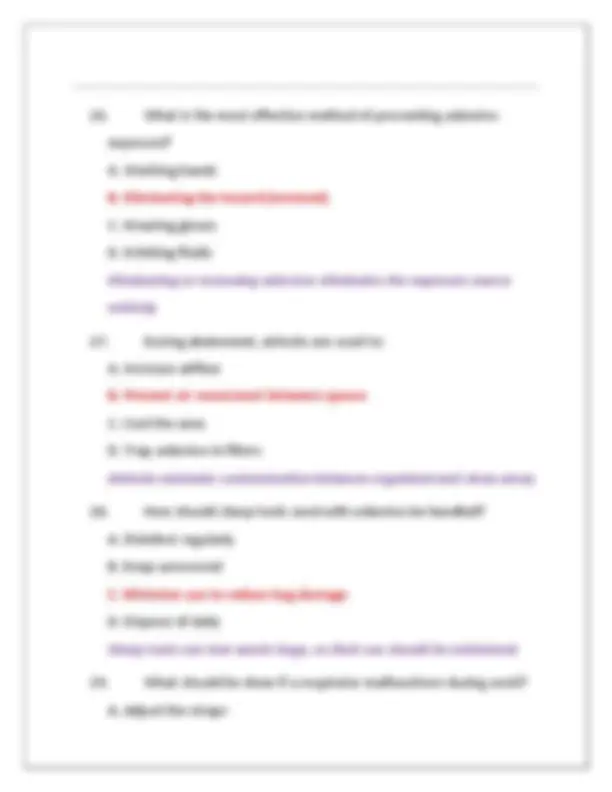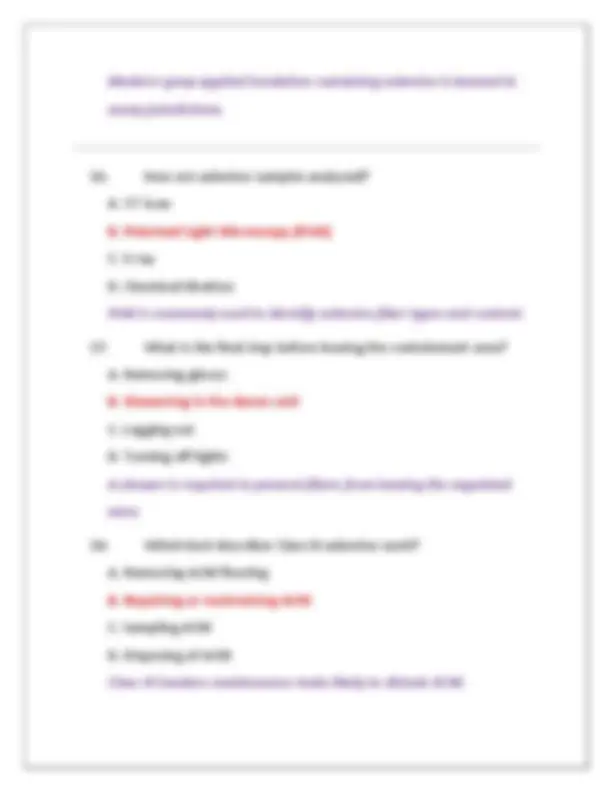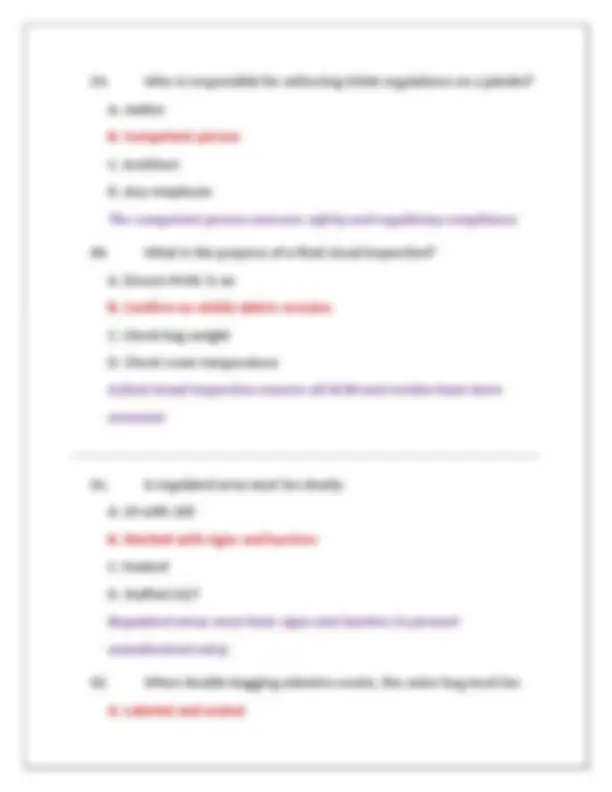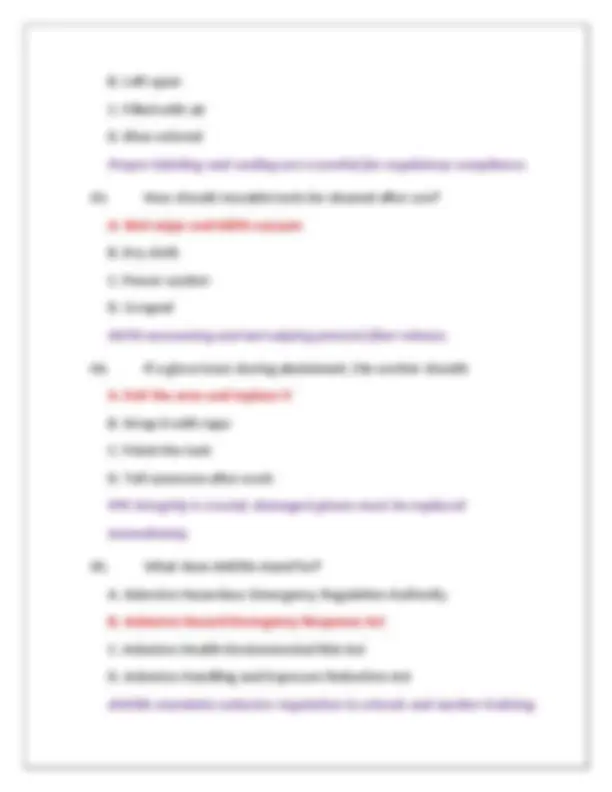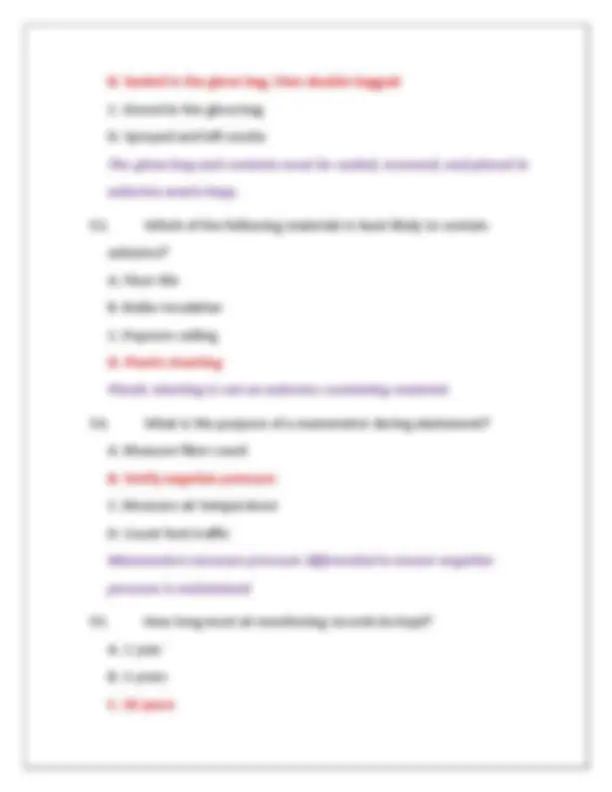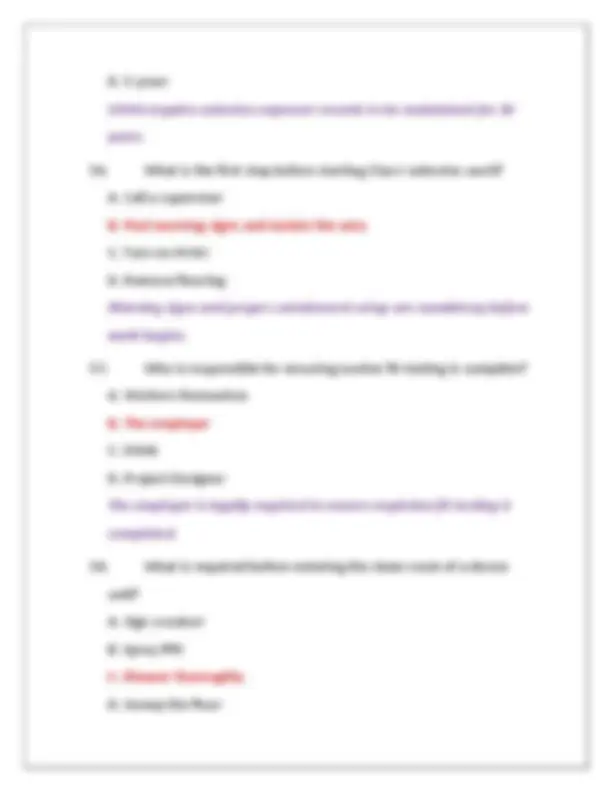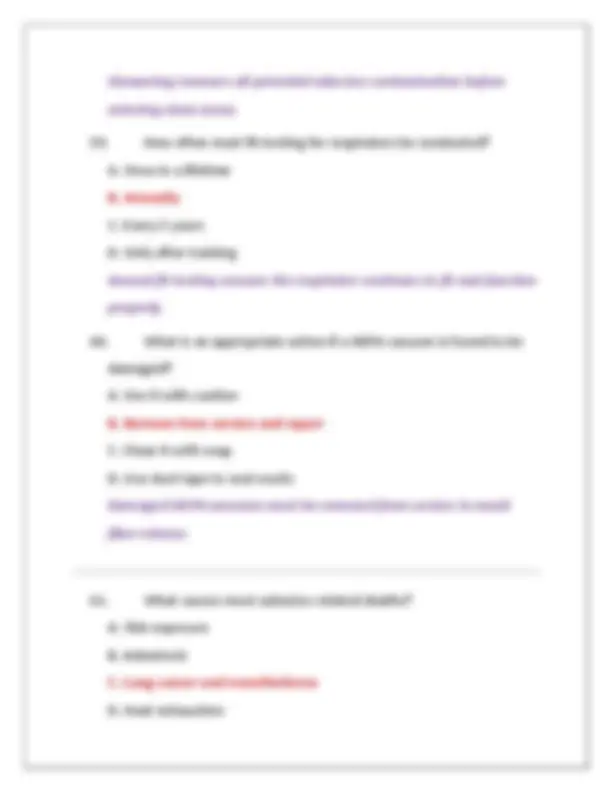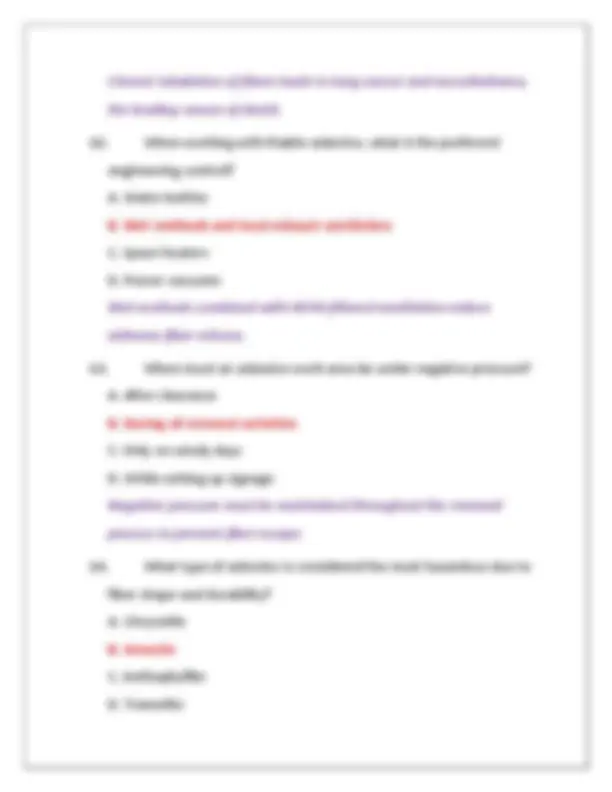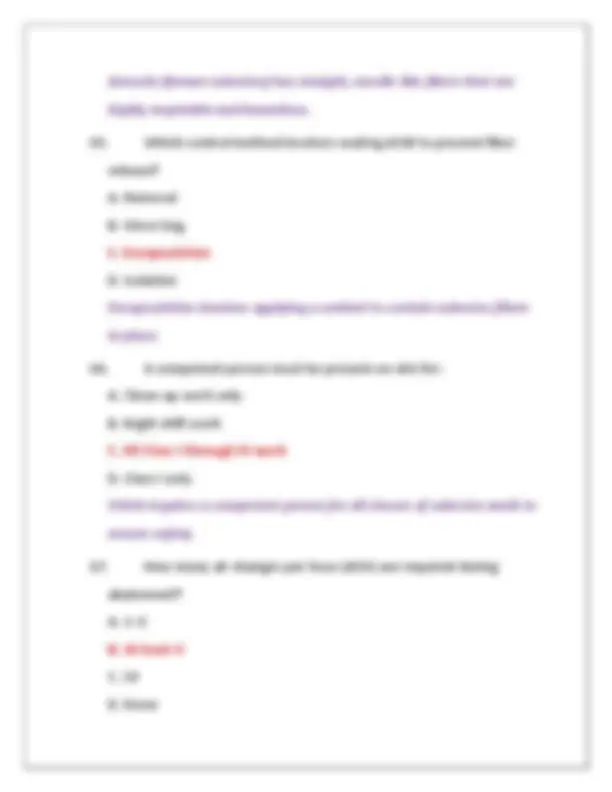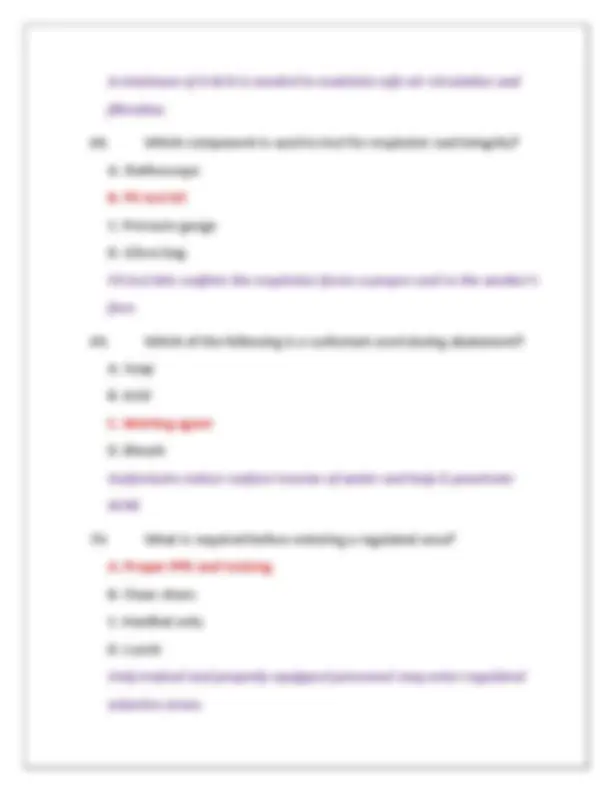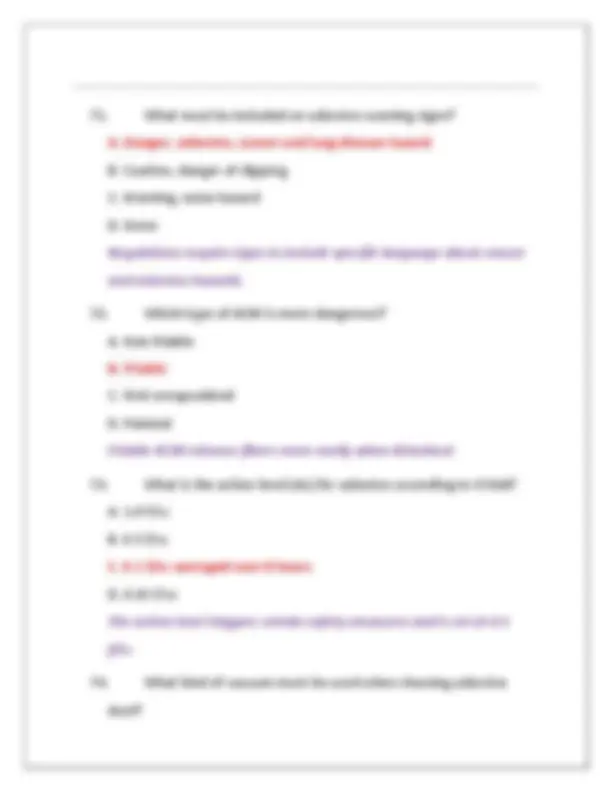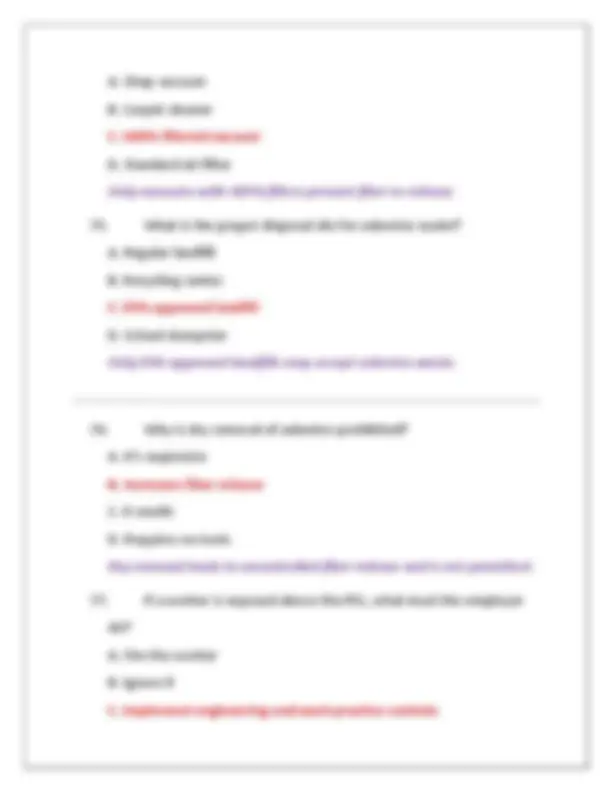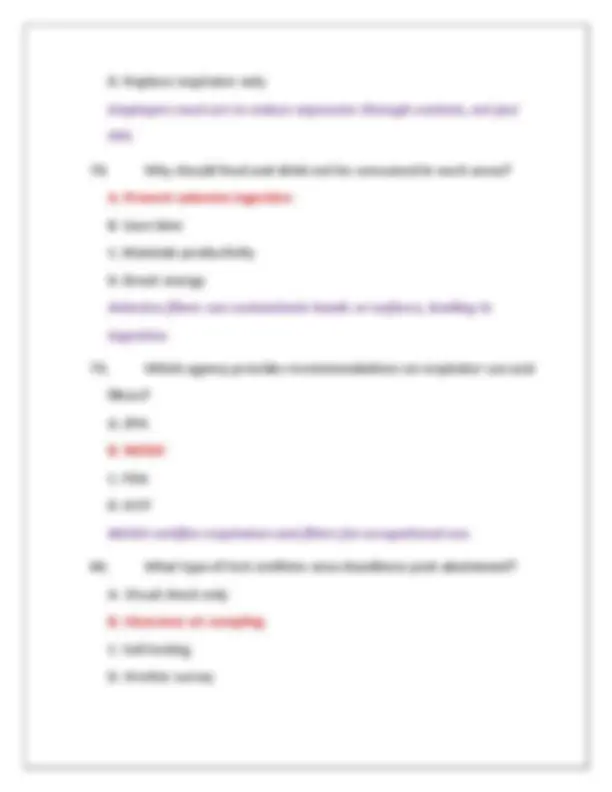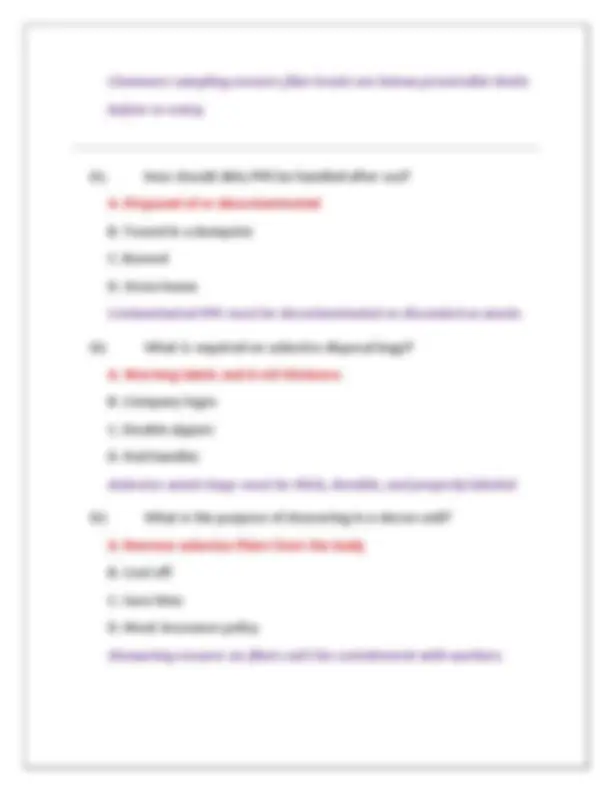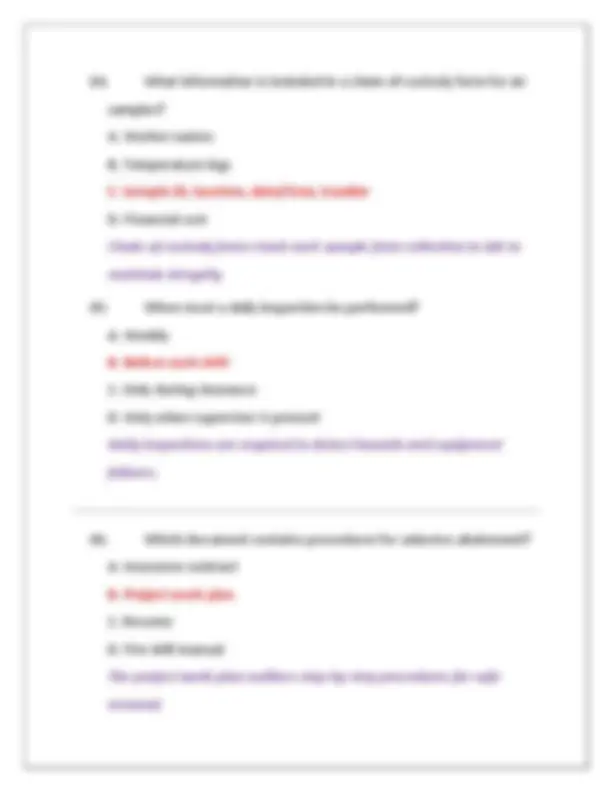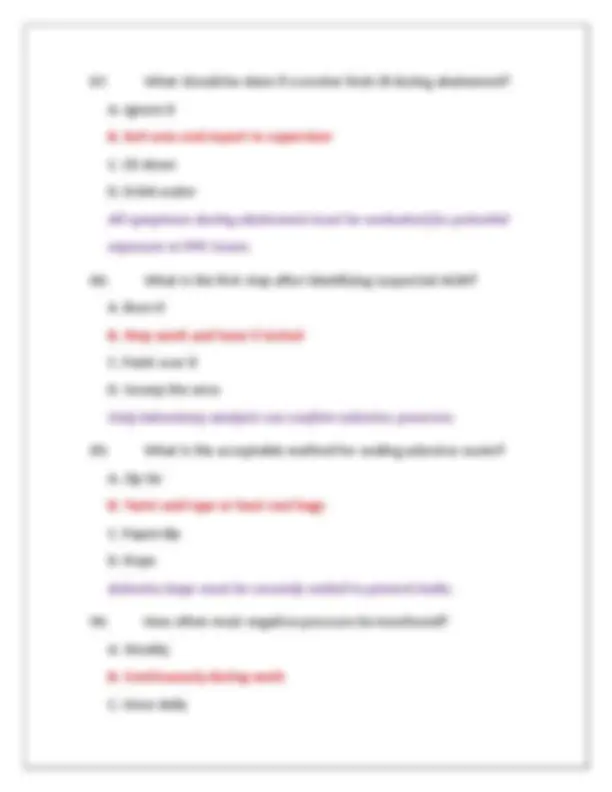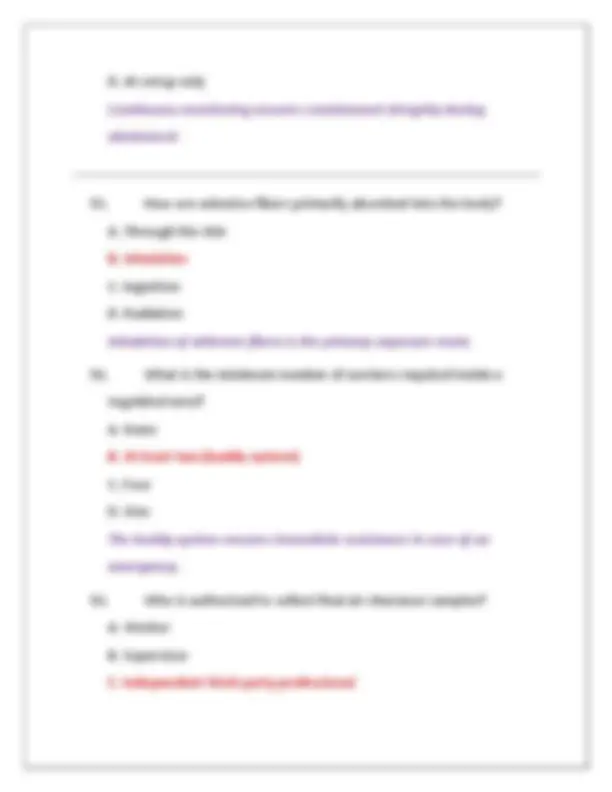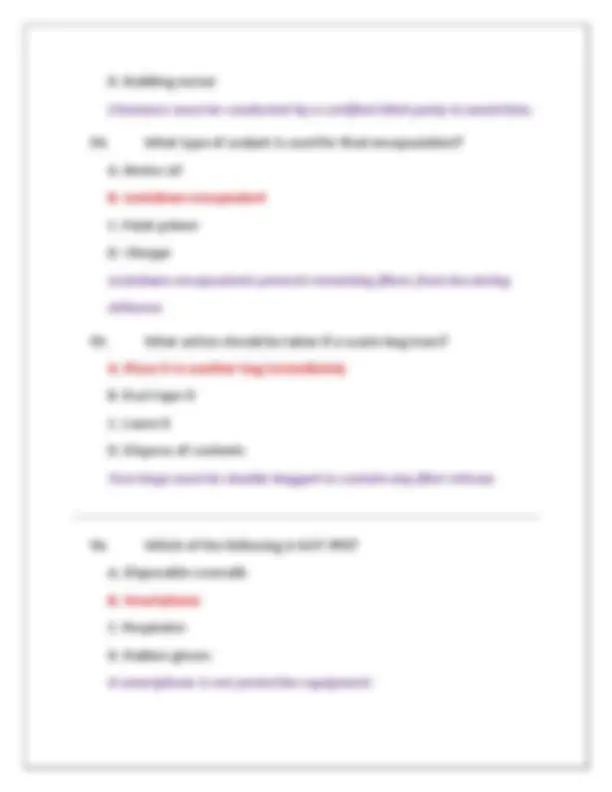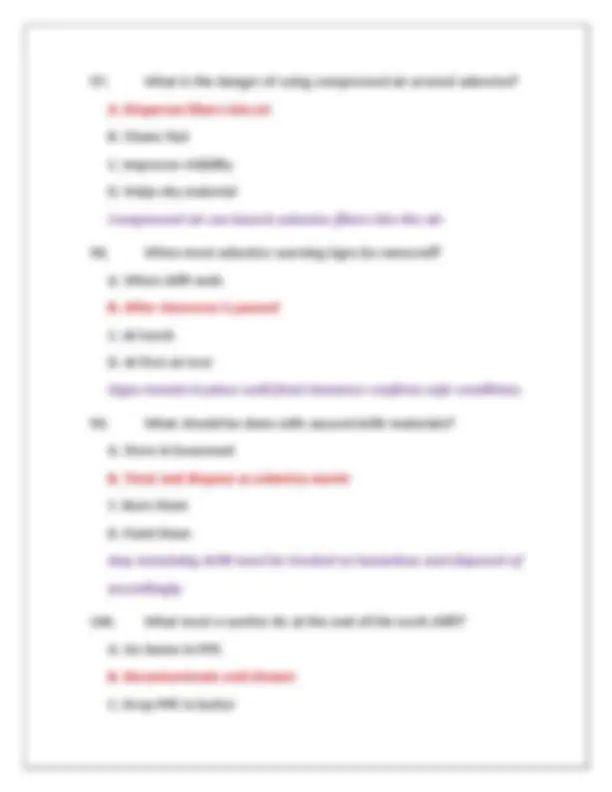Download Asbestos Worker/Handler Certification Exam 2 Practice QUESTIONS AND CORRECT ANSWERS (VER and more Exams Environmental Engineering in PDF only on Docsity!
Asbestos Worker/Handler Certification
Exam 2 Practice QUESTIONS AND
CORRECT ANSWERS (VERIFIED
ANSWERS) PLUS RATIONALES 2025 Q&A
| INSTANT DOWNLOAD PDF
- What is the primary health risk associated with inhaling asbestos fibers? A. Skin cancer B. Lung cancer C. Asbestosis D. Hepatitis Inhalation of asbestos fibers can lead to scarring of lung tissue, known as asbestosis, as well as lung cancer and mesothelioma.
- Which federal agency is responsible for regulating asbestos in the workplace?
A. EPA
B. OSHA
C. CDC
D. FDA
OSHA (Occupational Safety and Health Administration) sets and enforces workplace safety standards, including those for asbestos exposure.
- What is the OSHA permissible exposure limit (PEL) for asbestos averaged over an 8-hour workday? A. 0.1 fibers per cubic meter B. 1 fiber per cubic meter C. 0.1 fibers per cubic centimeter D. 1.0 fibers per cubic centimeter OSHA’s PEL is 0.1 f/cc averaged over an 8-hour time-weighted average (TWA).
- Which disease caused by asbestos exposure is a cancer of the lining of the lungs? A. Asbestosis B. Chronic bronchitis C. Emphysema D. Mesothelioma Mesothelioma is a rare but aggressive cancer strongly associated with asbestos exposure.
Respirators are required to protect against inhalation of asbestos fibers.
- Which type of respirator offers the highest level of protection? A. Half-face APR B. Full-face PAPR C. Surgical mask D. Dust mask Powered Air-Purifying Respirators (PAPR) with a full facepiece provide superior protection.
- What must be done to asbestos waste before disposal? A. Incinerate it B. Wet and double-bag it C. Dry it out D. Compact it Asbestos waste must be wetted, sealed in leak-tight containers or double-bagged in labeled 6-mil plastic.
- Which color bag is typically used for asbestos waste disposal? A. Blue B. Yellow or red with warning labels C. Clear D. Green Asbestos waste bags are color-coded and labeled with warning signs to ensure proper handling.
- What is a glove bag used for? A. Removing pipe insulation B. Transporting tools C. Mixing encapsulants D. Air sampling Glove bags are mini-containments used for safely removing asbestos from pipes.
- Before beginning abatement, what must be turned off to prevent fiber spread? A. Sprinklers B. HVAC system C. Water D. Gas supply HVAC systems can carry fibers throughout a building and must be shut down during abatement.
- When must workers receive asbestos safety training? A. Every 10 years B. Before starting work and annually C. After 6 months of employment D. After a safety violation OSHA requires initial and annual refresher training for asbestos workers.
- What should be done with disposable coveralls after use? A. Washed and reused B. Disposed of as asbestos waste C. Thrown in regular trash D. Donated Contaminated disposable PPE must be treated as asbestos- containing waste.
- Why is wetting asbestos important during removal? A. Keeps workers cool B. Reduces fire hazard C. Prevents fiber release D. Helps bag it faster Wetting asbestos keeps fibers from becoming airborne during handling.
- Which of the following is NOT an approved method of asbestos control? A. Enclosure B. Encapsulation C. Open-air dry scraping D. Removal Open-air dry methods are strictly prohibited due to high risk of fiber release.
- Which tool is safest for scraping asbestos material? A. Power grinder B. Sandpaper C. Hand scraper D. Wire brush Hand scrapers limit fiber release compared to mechanical tools.
- The decontamination unit must have how many chambers at minimum? A. One B. Two C. Three D. Four A proper decontamination unit includes an equipment room, shower, and clean room.
- After bagging asbestos waste, what must be done? A. Store for 30 days B. Label with appropriate warnings C. Mix with water D. Freeze for safety Waste must be clearly labeled with OSHA/EPA warnings about asbestos.
- What is the most effective method of preventing asbestos exposure? A. Washing hands B. Eliminating the hazard (removal) C. Wearing gloves D. Drinking fluids Eliminating or removing asbestos eliminates the exposure source entirely.
- During abatement, airlocks are used to: A. Increase airflow B. Prevent air movement between spaces C. Cool the area D. Trap asbestos in filters Airlocks minimize contamination between regulated and clean areas.
- How should sharp tools used with asbestos be handled? A. Disinfect regularly B. Keep uncovered C. Minimize use to reduce bag damage D. Dispose of daily Sharp tools can tear waste bags, so their use should be minimized.
- What should be done if a respirator malfunctions during work? A. Adjust the straps
B. Exit the regulated area immediately C. Clean it with wipes D. Finish the task Respirator failure requires immediate evacuation to prevent exposure.
- Which federal agency regulates asbestos waste disposal? A. EPA B. OSHA C. NIOSH D. FEMA The EPA oversees the handling and disposal of hazardous asbestos- containing materials.
- How often should a HEPA filter vacuum be inspected? A. Every 2 years B. Never C. Regularly per manufacturer’s instructions D. Before disposal Regular inspection ensures continued safe operation and filtration.
- What kind of documentation must be kept after an abatement project? A. Respirator cleaning logs B. Air monitoring records and waste manifests
Modern spray-applied insulation containing asbestos is banned in many jurisdictions.
- How are asbestos samples analyzed? A. CT Scan B. Polarized Light Microscopy (PLM) C. X-ray D. Chemical titration PLM is commonly used to identify asbestos fiber types and content.
- What is the final step before leaving the containment area? A. Removing gloves B. Showering in the decon unit C. Logging out D. Turning off lights A shower is required to prevent fibers from leaving the regulated area.
- Which best describes Class III asbestos work? A. Removing ACM flooring B. Repairing or maintaining ACM C. Sampling ACM D. Disposing of ACM Class III involves maintenance tasks likely to disturb ACM.
- Who is responsible for enforcing OSHA regulations on a jobsite? A. Janitor B. Competent person C. Architect D. Any employee The competent person oversees safety and regulatory compliance.
- What is the purpose of a final visual inspection? A. Ensure HVAC is on B. Confirm no visible debris remains C. Check bag weight D. Check room temperature A final visual inspection ensures all ACM and residue have been removed.
- A regulated area must be clearly: A. Lit with LED B. Marked with signs and barriers C. Heated D. Staffed 24/ Regulated areas must have signs and barriers to prevent unauthorized entry.
- When double-bagging asbestos waste, the outer bag must be: A. Labeled and sealed
- Which class of asbestos work includes clean-up of debris? A. Class I B. Class IV C. Class II D. Class III Class IV involves maintenance and clean-up tasks after asbestos work.
- What are the symptoms of asbestosis? A. Skin rash and itching B. Shortness of breath and dry cough C. Diarrhea D. Fever and chills Asbestosis affects lung function and causes respiratory symptoms.
- An asbestos worker must receive medical exams: A. After age 50 B. Annually if exposed above the PEL C. Only once at hiring D. Only if symptomatic Annual exams are required when workers are exposed at or above the PEL.
- How should filters from HEPA vacuums be treated? A. Recycled
B. Disposed of as asbestos waste C. Rinsed and reused D. Burned Filters may contain asbestos and must be handled as hazardous waste.
- When is a clearance air test conducted? A. Before starting work B. After final cleaning C. Mid-project D. While bagging waste Clearance tests confirm the area is safe for reoccupancy post- abatement.
- What is the minimum efficiency of a HEPA filter used in asbestos abatement? A. 95% B. 99.97% at 0.3 microns C. 90% D. 85% HEPA filters must remove 99.97% of particles ≥0.3 microns to prevent fiber exposure.
- During glove bag removal, how should waste be handled? A. Tossed in a trash bin
D. 5 years OSHA requires asbestos exposure records to be maintained for 30 years.
- What is the first step before starting Class I asbestos work? A. Call a supervisor B. Post warning signs and isolate the area C. Turn on HVAC D. Remove flooring Warning signs and proper containment setup are mandatory before work begins.
- Who is responsible for ensuring worker fit-testing is complete? A. Workers themselves B. The employer C. OSHA D. Project Designer The employer is legally required to ensure respirator fit-testing is completed.
- What is required before entering the clean room of a decon unit? A. Sign a waiver B. Spray PPE C. Shower thoroughly D. Sweep the floor
Showering removes all potential asbestos contamination before entering clean areas.
- How often must fit-testing for respirators be conducted? A. Once in a lifetime B. Annually C. Every 5 years D. Only after training Annual fit-testing ensures the respirator continues to fit and function properly.
- What is an appropriate action if a HEPA vacuum is found to be damaged? A. Use it with caution B. Remove from service and repair C. Clean it with soap D. Use duct tape to seal cracks Damaged HEPA vacuums must be removed from service to avoid fiber release.
- What causes most asbestos-related deaths? A. Skin exposure B. Asbestosis C. Lung cancer and mesothelioma D. Heat exhaustion

